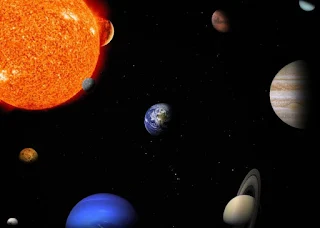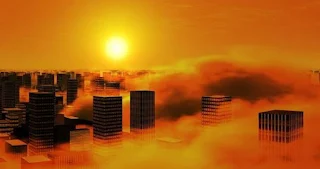The sun exploded? Wow, a phrase that might make your disco goose bumps. Because you can't imagine a celestial body of that size having to explode in the midst of the many planets that orbit it, including planet Earth.
Never mind the sun, just seeing the Bali bombings made our hearts beat fast. Moreover, the sun is the center of the solar system. Reportedly, several space scientists (astronomers) have conducted several studies regarding this event.
Some of them say that the sun will actually explode in about 6 years, and its explosion is estimated to be trillions of times more powerful than the bombing of Hiroshima. Before we discuss whether the sun will explode, maybe we should talk about the "profile" of the sun itself.
The sun is the center of the solar system, maybe you have known it since elementary school. In fact, it was known by people before us in the 16th century since Nicolaus Copernicus presented his theory of scientific truth. But do you know what the characteristics of the sun are?
The sun is a celestial body in the form of a glowing ball (like a garden lamp) which has the main constituent compounds and consists of 74% hydrogen, 25% helium, ionized, and compounds consisting of nickel, sulfur, silicon, iron, carbon, neon , calcium, and chromium. Then, how is the sun able to glow and produce its own light? It comes from the fusion reaction of hydrogen compounds into helium.
The size of the sun can be estimated to be about 109 times the diameter of the planet Earth, so it is not surprising that the sun is the largest object in the solar system. The sun is included in the star category, and is the star closest to Earth with a distance of approximately 150 million km.
The age of the sun is estimated to be about 4.6 billion years, and its characteristics have a surface temperature of up to 6 thousand degrees Kelvin. Based on the observations of some scientists, the temperature of the sun will cool down after about 7 billion years when the hydrogen in its core runs out.
If so, the sun expands into a red giant star and devours the small planets around it, (Earth is no exception) and then returns to being a small star. While the attraction (gravity) of the sun can be calculated as 28 times stronger than the gravity of the Earth so that if a person weighs 50 kg on Earth, it means he will weigh 1400 kg on the sun!
Then, what is the function of the attraction of the sun? To find a partner? or attract the opposite sex? Certainly not. However, the attraction or gravity of the sun functions as a puller for the elements that make up the sun, and serves to maintain the planets around it in order to remain in their respective orbits.
Implications of Solar Activity
The sun plays an active role in our life on Earth in particular, and in space in general. The sun regularly emits radiation, magnetic fields, and particles throughout space. The emission is increasing impulsively so that the sun has an important role in creating weather variability in space.
Although our Earth has an atmosphere that serves to protect it from space "weather", space is not free from this weather. So that if a space storm occurs, it can cause damage to spacecraft, satellites, to communications and navigation.
In addition, if the sun explodes, the explosion (flare / CME) can cause a "Halloween Storm" which has an impact on radio communication failures, as well as damage to satellites and power lines as happened in Sweden a few years ago.
Supernova
The supernova that the author is talking about today is not a novel by the famous Indonesian Novelis Dewi "Dee" Lestari, but a supernova in the context of Astronomy. A supernova is an explosion from a star in a galaxy to be able to emit quite a lot of energy.
If this supernova event occurs on a star, it means that the star has "finished" and will look so bright that it reaches hundreds of millions of times more brilliant light than before.
Supernova occur every 50 years, it serves to enrich the interstellar medium as well as elements of greater mass. There are four types of supernovae, namely:
- Type laa: the characteristics of this type of supernova is the absence of hydrogen spectral lines.
- LBC type: this type of supernova does not find hydrogen and helium lines.
- Type II: this type of supernova, the discovery of the hydrogen line.
- Hypernova type: this type of supernova releases enormous energy when it explodes. This energy is greater than the energy of other types of supernova.
Meanwhile, based on the energy source, a supernova is divided into two types, namely thermonuclear supernova and core-collapse supernova. In the following, the author will describe several stages of this supernova event:
Swelling of the star will swell into a red giant star because it sends a helium core inside its surface. Meanwhile, the inner core of the star will shrink so that it will heat up and condense.
The iron core that remains when all major parts of the star have disappeared is elemental iron. The nuclear structure of iron does not allow the atoms in the star to fuse into heavier elements and so the star enters a stage of disintegration.
Explodes when the temperature of the star's core has reached about 100 billion degrees Celsius, and the energy from the star's core is transferred to surround the star, the star explodes and spreads an immeasurably powerful shock wave.
Throwing materials found in stars to the corners of space.
From the explosion, what will the impact on the space order be? there are two effects, namely:
- Produce metal, as the author has discussed previously about the fusion reaction of a star, and the reaction arises from elements heavier than hydrogen and helium. When a supernova occurs, these elements will fill the clouds between the surrounding stars with metallic elements.
- Generating new stars, the elements that fill the interstellar cloud will move to other parts of space and are expected to form new stars and new planets.
The Sun (will) Explode
If there can be an explosion (supernova) on a star, then what about the sun? Because the sun is included in the category of stars, it is possible for the sun to explode.
You will see the presence of flames on the surface of the sun from satellite photos that extend about 30 times the diameter of the Earth. In addition, there is an increase in the temperature of the sun to reach 27 million degrees Fahrenheit. Wow, I can't imagine how hot it is.
From satellite photos it can be seen that the flames on the sun's surface have extended about 30 times the diameter of the Earth. Temperatures have also risen sharply from the previous 27 million degrees Fahrenheit to 49 million degrees in recent years.
“This shows that the sun is ready to explode. The explosion was roughly equivalent to a nuclear bomb whose effect was trillions of times more powerful than the bomb dropped on Hiroshima,” said Dutch astronomer Dr. Piers Van der Meer, who is also the European Space Agency's expert staff.
That's the opinion of Dr. Piers, I don't know if a sun exploding is really going to happen or not. The research led to things that managed to make us all feel anxious. If so, God's help is the most important. Just pray!


